Teach Your Child to Read in 100 Easy Lessons: Revised and Updated Second Edition
£12.30
* Is your child halfway through first grade and still unable to read?
* Is your preschooler bored with coloring and ready for reading?
* Are you worried that your child will become lost in overcrowded classrooms?
* Did you know that early readers hold an advantage over their peers throughout school?
* Do you want to help your child read, but are afraid you’ll do something wrong?
SRAs DISTAR® is the most successful beginning reading program available to schools across the country. Research has proven that children taught by the DISTAR® method outperform their peers who receive instruction from other programs. Now for the first time, this program has been adapted for parent and child to use at home. Teach Your Child to Read in 100 Easy Lessons is a complete, step-by-step program that shows patents simply and clearly how to teach their children to read.
Twenty minutes a day is all you need, and within 100 teaching days your child will be reading on a solid second-grade reading level. It’s a sensible, easy-to-follow, and enjoyable way to help your child gain the essential skills of reading. Everything you need is here — no paste, no scissors, no flash cards, no complicated directions — just you and your child learning together. One hundred lessons, fully illustrated and color-coded for clarity, give your child the basic and more advanced skills needed to become a good reader.
Teach Your Child to Read in 100 Easy Lessons will bring you and your child closer together, while giving your child the reading skills needed now, for a better chance at tomorrow.
Read more
Additional information
| Publisher | Avid Reader Press, Simon & Schuster (1 Jun. 1986) |
|---|---|
| Language | English |
| Paperback | 420 pages |
| ISBN-10 | 0671631985 |
| ISBN-13 | 978-0671631987 |
| Dimensions | 21.27 x 2.29 x 27.94 cm |

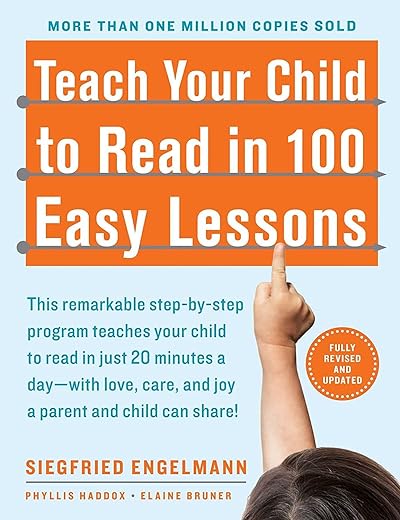
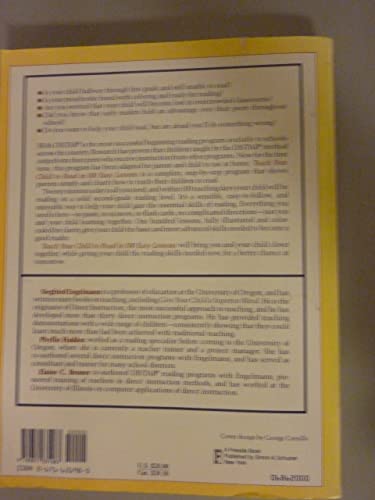

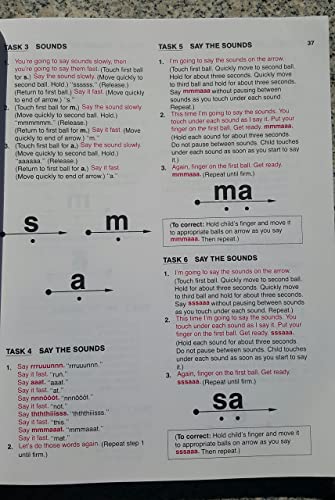
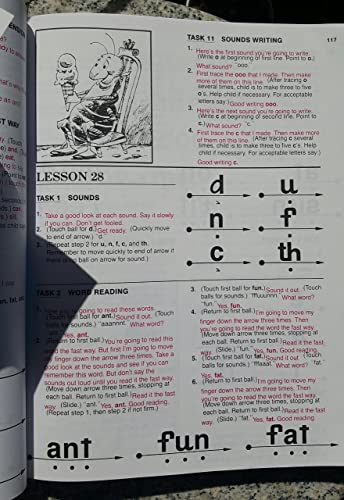
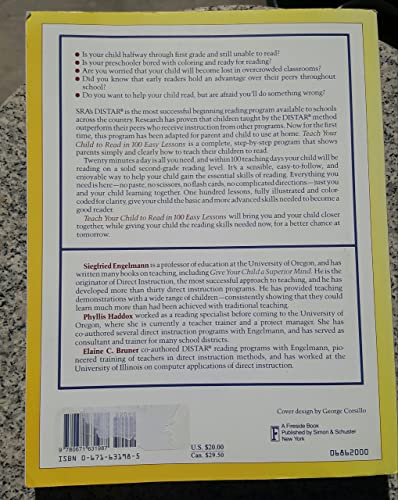
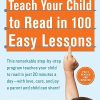
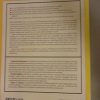
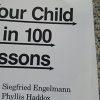



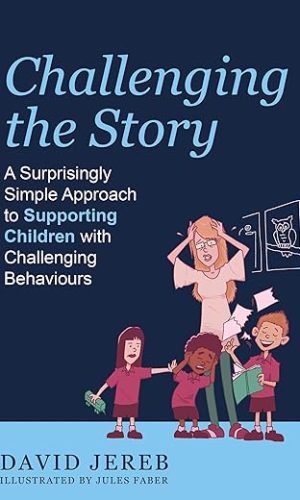
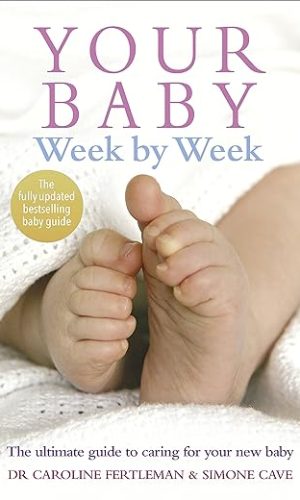

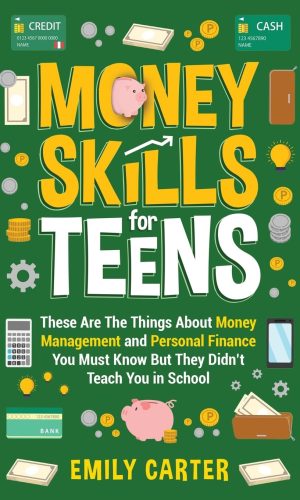
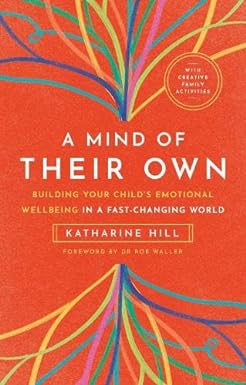
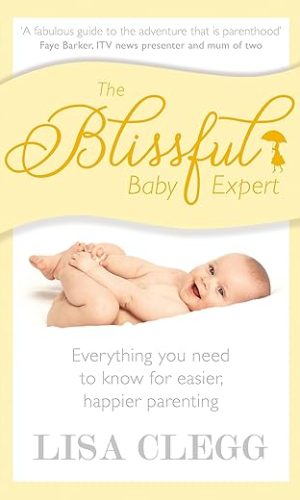

by J. Brown
Tonight my daughter (age 3 yrs 8 months) read her own bedtime stories – proper little tales, not just “cat sat on a mat”. She has done about 80 of the 100 lessons, no more than 20 minutes a day and about 5 times a week. She’s very bright but due to having an October birthday, won’t start formal schooling for another year and I knew that she would be very frustrated without some intellectual challenges. She asked to learn to read and I had no idea how to teach her – how you you explain “read” and “red” and “read” and “reed” and so on?
This book tells you – it is VERY proscriptive, you must say the words exactly as they tell you, even down to how to praise your child (but I slipped from that a little as we went on and grew in confidence). Other reviewers have criticised the strange symbols and the use of little letters etc, and I wondered how she would move from this strange almost-code to proper writing, but she just did. I can’t explain how, but her mind coped with it with no problem at all.
To start with, I found the programme daunting – pages of explanation before you get into it, and I worried I would set my daughter back by putting her off reading entirely. This was not the case at all.
Good points:
+ it really works
+ you start to see results very soon
+ the child gets a great sense of achievement
+ the authors really know what they are talking about, even if you don’t believe it at first – for example more than one lesson back to back is inadvisable, even if your child finished the first lesson eager for more.
Bad points:
– it is American, so one has to translate “sidewalk” and “mom” etc
– there are far too many typing errors, missing the pronunciation marks off letters etc, we had to go through the book putting them in with black pen.
– some of their pronunciation is bizarre: “for” to be pronounced rhyming with “mower” for example?! Is it the American accent, or is it just sloppy editing? We just ignored this after a while.
For me it loses 2 stars for the sloppy editing, but as the programme still works so effectively, I’ve given it a bonus star to make up for taking off 2 – the programme is almost perfect, the publishers need to sharpen up their act!
I will use it again for my son.
PS (added later) she’s now nearly 4 and on stage 2 of the reading scheme – her class mate have not started it yet!
by ECM
Its logical, and each lesson is short. You can makelessons shorter by skipping the last couple of exercises too.
It really works and quickly too. By lesson 20 you are seeing it click by lesson 40 they are reading (slowly sounding it out) and by lesson 80 its amazing how good they are.
We are doing this book with a bright 2 year old, who asks for it every day. I don’t think every kid will ask as it is a bit dull, but the progress is remarkable and it makes them feel so good about themselves.
by Treasa
Great resource for kids that are learning to read – we’re dipping in and out (when time allows) but my 3 year old is already understanding certain letters, what they look like and the sounds that they make. It’s easy to use this book and dip in and out for short sessions, and it makes it really easy.
by S.K.
I used this book with my daughter when she was 4 to 5. It did work but I had to encourage her a lot to do this because she just found this book boring. In the end we never completed this. That said, my daughter is someone who dislikes structured teaching and this book offers a structured curriculum. She’s 7 now and reads at a 9 or 10 year old level, and she taught herself to read eventually at about 5 to 6 years old without this book. That is not to say this is a bad book, just that it does not suit every child.
EDIT : Well after 2 more kids, I’ve changed my mind. I’ve been home educating my kids for the last 4 years and I have used this book successfully to teach both my 2 younger kids to read. Okay so maybe this book doesn’t work for my eldest, but I will give the book 4 stars out of 5 for teaching 2 of my 3 kids to read. It is a bit dry in delivery though, and it did become a bit of a drag doing this with my middle child towards the last 10 lessons or so. But my youngest, for some reason, really loved ALL of the stories in the book, so doing it with him was a joy even up till the end. And because he took to it so well, I bought all of the 20 odd recommended story books for him listed at the end of this book, to be used after he has completed the course, and now he has finished about 15 of them and going on to do the last 5 or 6. If you are going to be doing this, I have to warn you that the reading level required to read the last 3 books really does jump up a bit considerably. Especially the Look Out! Washington D.C. book… It is like a full-on paperback chapter book with lots of words. I’m not sure how my son is going to cope with that. He is a good reader but that book seems to me like a book even 9 or 10 year olds would read, and my son is only 6. But he has coped well with all of the first 15 or so books on the recommended reading list in this book so we’ll see how he does at the last book. I wouldn’t mind putting it aside for a while if he hates it.
by Sara Carrickson
This book is a comprehensive and effective way of teaching your child the fundamentals of decoding words. It teaches the most common sounds and teaches the right way of attacking words – by trying to decode them (i.e. sound them out). We started when our son was three and my son is now 4.5 and we’re only on lesson 78 – but he is reading. We do 5-10 minutes a day and split a lesson over a week or even more. This has worked really well for us and we anticipate he will finish the book before he starts reception. We didn’t bother teaching him how to write but in retrospect wish that we had done!
I will say that it doesn’t teach some common sounds, perhaps due to accent differences? For example “ow” as in “how, cow, now” is not taught. I assume in an american accent “o” as in “ox” and “w” as in “win” together make the right sounds for “how”. But with my southern English accent you have to teach “ow” separately to get the right sound. You will also have to teach “ear” as in “hear”, “ir” as in “girl”. The book does eventually teach “ai” as in “rain” and “ea” as in “read” but I would teach these much earlier as they pop up in several stories before they’re formally taught. I’d also teach “ay”, “oy”, “oi” as these are not formally taught but are in the book, again perhaps an accent difference.